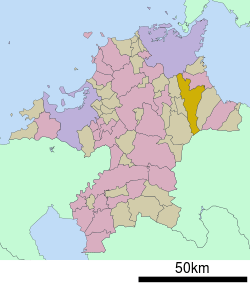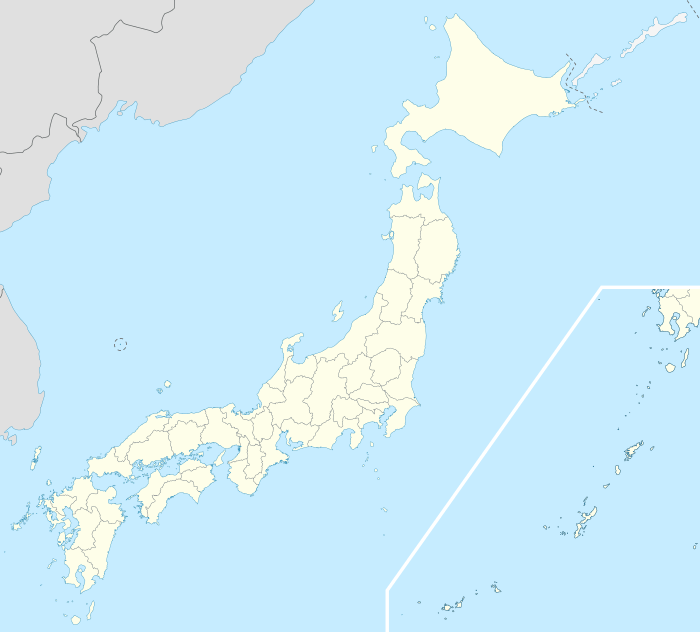Miyako, Fukuoka
| Miyako みやこ町 | ||
|---|---|---|
| Town | ||
| ||
 Location of Miyako in Fukuoka Prefecture | ||
 Miyako Location in Japan | ||
| Coordinates: 33°42′N 130°55′E / 33.700°N 130.917°ECoordinates: 33°42′N 130°55′E / 33.700°N 130.917°E | ||
| Country | Japan | |
| Region | Kyushu | |
| Prefecture | Fukuoka Prefecture | |
| District | Miyako | |
| Area | ||
| • Total | 151.28 km2 (58.41 sq mi) | |
| Population (February 28, 2007) | ||
| • Total | 23,178 | |
| • Density | 150/km2 (400/sq mi) | |
| Time zone | Japan Standard Time (UTC+9) | |
| Website | Town of Miyako | |
Miyako (みやこ町 Miyako-machi) is a town located in Miyako District, Fukuoka Prefecture, Japan.
The town was founded on March 20, 2006, by the merger of the towns of Katsuyama 勝山, Saigawa 犀川 and Toyotsu 豊津, all from Miyako District.
As of February 28, 2007, the town has an estimated population of 23,178. The total area is 151.28 km²
Saigawa
Saigawa District is surrounded by mountains and the Imagawa and Haraigawa rivers flow through it. Fukuoka Prefectural Road 34 and the Heisei Chikuho railway run east and west through the district. The Shinto god Sai no Kami was enshrined at a crossing place along the Imagawa. The town takes 'Sai' from Sai no Kami and 'gawa' from 'kawa' or 'river'.
History
In 1905 East Saigawa Village, West Saigawa Village, and Minami Saigawa Village merged to form Saigawa Village. In 1943 Saigawa Village became Saigawa Town. In 1956 Irahara Village was annexed by Saigawa Town. In 2006 Saigawa merged with Katsuyama and Toyotsu to become Miyako.
Irahara
Irahara is located in Miyako town near Yukuhashi in Fukuoka. It is 253m above sea level, 33°42'N, 130°55'E.It is along Route 496 and about 40 minutes by car to the South from Yukuhashi. It is surrounded by beautiful nature. The area is 2356km2. The population of the area is 284.

History
Peple began to live in Irahara in the Jomon period about 3000 years ago. Most of Irahara will sink under water because Irahara Dam has been built.
Landmark Architecture
A historical building ios the Naganuma House. It was built in 1839. It shows the way of life in the Edo era.
Wildlife
We can see wild animals. They are deer, boars, and rabbits.
Kagura
Irahara is famous for a traditional Noh dance called Kagura. It is offered for the gods of Shinto. The actions show the stories of Japanese mgths. It has been passed down from parents to children for generations.
Irahara Dam
Miyako Town has been suffering from floods. A multi-purpose dam is under construction in Irahara in order to prevent floods and hold tap water. This dam is called Irahara Dam. It will be finished in 2017.
Harai River
Harai River flows through Irahara to Yukuhashi City. The length is 31km. It is famous for fire flies in early summer and many people visit to enjoy swimming in the hot summer.
Festivals
Many festivals are held through the year. They are mainly concerned with agticlture. The festival called Jinkosai in May is the largest. At that time we enjoy kagura very much.
Food
The famous foods are hawasabi and rice. Hawasabi is very hot, and the rice is very delicious.
Climate
In spring the mountains are full of fresh greens and we can see beautiful scenery. In summer the river water is very clean, so we can siwm there. In autumn the whole forest turns red and becomes very beautiful. In winter there are very pure snow scenes and we can sometimes play with snow.
Irahara Junior High School
Irahara Junior High's school buildings will be sunk under the Irahara Dam. So,Irahara Junior High School will be moved and re-built.It is designed by Mr Ando Tadao, one of the most famous architects in the world. He intended to construct a perfect wooden building. Construction will start in 2015.
References
External links
![]() Media related to Miyako, Fukuoka at Wikimedia Commons
Media related to Miyako, Fukuoka at Wikimedia Commons
- Miyako official website (Japanese)